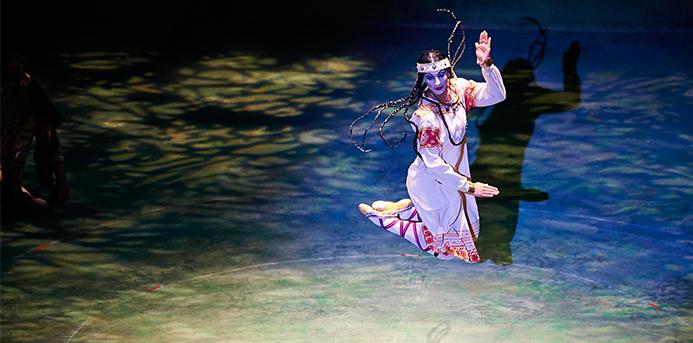It’s safe to say that no one around today attended the world premiere performance of “The Rite of Spring” a century ago.
The ballet Nijinsky choreographed to the music of Stravinsky for Diaghilev’s Ballet Russes was so raw and primitive it incited a riot in the Theatre des Champs-Elysees that also flowed out onto the Paris streets the evening of May 29, 1913.
No such commotion ensued at this historically reverent reconstruction of the work depicting a pagan fertility rite. Nijinsky’s choreography is indeed primitive—mostly, the dancers jump in place and run around in circles. Their posture rarely approaches the graceful, often they stand pigeon-toed. At one point a dancer stands motionless with her head awkwardly sideways, as if her neck has been broken.
That Chosen One is danced by Joanna Wozniak, and 37 members of the Joffrey company take part in this vast production. The costumes hue to the original’s tribal designs. Women wear headbands and braids, their clothing in colors of red, blue, brown or white. Male dancers wear cone hats, and as the drama heats up—the sacrifice is coming soon—a group of them appear in bearskins over their robes and heads.
A short film shown prior to the ballet recounts the reconstruction meticulously done by Millicent Hodson and Kenneth Archer, at the initial suggestion of the late Robert Joffrey in 1987.
The night combined other Russian choreographers with Russian composers, and included George Balanchine’s glorious 1956 “Allegro Brillante” to the music of Tchaikovsky. The stars were April Daly and Dylan Gutierrez, backed by four other couples. Balanchine is all about putting the spotlight on the ballerina and Daly not only dances like a sprite, but seems delighted to be on stage. At one point the orchestra falls silent and only the piano is heard, as she executes intricate footwork and positions that match the bubbling keyboard.
This was followed by “Adagio,” choreographed by Yuri Possokhov in 2012 to music of Khachaturian’s “Spartacus.” It was danced by Victoria Jaiani and Temur Sulaushvili, she the most sinuous of the Joffrey women and he tall as an oak and just as strong. It begins with him sitting on the floor and she walking toward him. They intertwine, their limbs tangling and unwinding, as intricately molded as a sculpture. She leaps into his arms and over his shoulder, then suddenly appears in front of him! They were breathtaking, and then she leaves the stage, and he is alone again.
Possokhov’s mood is lighter in “Bells,” choreographed for five couples to piano pieces by Rachmaninoff, played elegantly in the pit by Mungunchimeg Buriad and Kuang-Hao Huang. The dance starts and ends with the fourth movement of the composer’s Fantasie Tableaux, its bell-like rhythms deftly imitated by the dancers. It includes a series of groupings. Particularly powerful is a set by three women, in head scarves. They are surely sisters and embraced by Rachmaninoff’s lush music, they slide apart and move together, at one point arranged as if adorning a plaza fountain.
The dances, accompanied by the Chicago Philharmonic under the baton of its music director Scott Speck, provided an entirely satisfying evening and runs through Sept. 22. The Joffrey’s fall presentation is the story ballet “La Bayadere,” based on Petipa’s original choreography to the music of Ludwig Minkus and running Oct. 16 to 27 at the Auditorium.
The company’s most beloved story ballet is “The Nutcracker,” choreographed by Robert Joffrey to the Tchaikovsky score. It will have 23 performances from December 6 through 28.
There are sure to be more story ballets in the company’s future. The Rudolf Nureyev Dance Foundation has given the Joffrey a $500,000 challenge grant to establish an endowment for the creation, production and performance of full-length story ballets. The Joffrey Board and its new chairman Zachary D. Lazar, Jr. are now tasked with raising $1 million to complete the fund.

